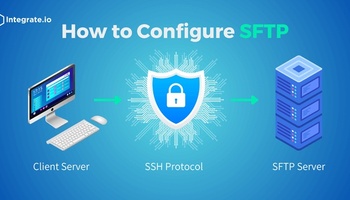- Mishandling Old Equipment Containing PII Data
- Using Noncompliant Cloud Storage and Services
- Improperly Sending PII Through Data Pipelines
- Lacking Awareness of Digital and Physical Environments
- Failing to Protect Data at All Stages
- Using Poorly Suited Security Policies and Technology
- Integrate.io is a Compliant Data Pipeline Solution
Personally identifiable information, or PII, is sensitive information that can identify an individual. Industry or data protection laws often regulate this type of data, requiring that organizations handle PII according to specific practices. It’s all too easy to make mistakes when working with PII, so we've highlighted six common scenarios to look out for.
1. Mishandling Old Equipment Containing PII Data
What do you do with your old workstations, hard drives, and other media that contain PII data? If you don’t dispose of it properly, you could be putting this information at risk of being breached. The process for handling this equipment varies based on your industry, the type of data you’re working with, and the regulations your organization falls under.
For example, you might need to keep records for a certain period of time before you’re able to destroy them. You would need to move this data off any equipment that’s slated for destruction or sale before that time. It can go into cold storage if you don’t need to access it frequently, which could reduce your data storage expenses.
You need to use disposal methods that ensure you remove all PII from the storage device. Simply formatting a hard drive is not enough to stop the data from being retrieved by an unauthorized party. There are many service providers that can help with the proper disposal of company equipment; they have the specialty equipment needed to handle this task safely and efficiently.
While you’re considering your old equipment, also look for ex-employee accounts on network drives. Regularly deactivate these accounts and clear the drives of data for employees who are no longer with your organization.
2. Using Noncompliant Cloud Storage and Services
Cloud-based data storage is a cost-effective way of working with the ever-increasing data volume many organizations deal with, but it may pose a risk to your PII data. If a cloud service doesn’t expressly state that it complies with the regulations that your organization must follow, you could face fines and other costly consequences.
For example, if the cloud service is in a different country, then you may run into problems with region-specific regulations such as GDPR in the EU. You may be able to choose the physical location of the cloud resources you’re using, but this option is not always available.
When you’re working with third-party providers and sending PII data to their services, check on any details relevant to compliance. Ask about their data security standards, their policies concerning sensitive information, where the data is physically located, and the regulations they follow.
3. Improperly Sending PII Through Data Pipelines
Analytics software requires data collected from many sources, such as your internal databases, SaaS platforms, and third-party sources. Because of the volume of data and the number of sources used, organizations may have automated data pipelines for streaming the data to a destination data warehouse or data lake. From there, the data goes through analysis in the analytics solution.
PII data may mix in with these data sets. Unauthorized parties may view or access it, or authorized users could use it for impermissible purposes. You can use an Extract, Transform, Load (ETL) tool to mask the PII data before it reaches its destination so that this sensitive information is safe. With this method, you can use real-world values without compromising data privacy.
Depending on the type of data and the regulations your organization must follow, you may be able to use an ETL tool to remove PII from the data set entirely.
4. Lacking Awareness of Digital and Physical Environments
Is PII accidentally exposed because of a lack of physical security and data privacy awareness in your organization? Anyone accessing PII data should know the state of the digital and physical environments around them.
For example, employee devices should auto-lock when workers step away from their workstations. When employees are working with sensitive data, they should also be aware of anyone within viewing distance of their display. Your organization needs policies and procedures in place to control the entrances to areas of the building containing PII data.
General cybersecurity awareness is also important for your organization. Social engineering and phishing tactics can cause significant damage and may expose PII, and creating a security-centric business culture can reduce this risk.
5. Failing to Protect Data at All Stages
Data exists in three states: in motion, at rest, and in use. If your data protection methods only cover one or two of these, then PII is at risk whenever it goes through the other stage(s). The ideal data protection solutions vary based on each stage.
Encryption helps significantly when you’re working with data in motion and at rest. You’ll want to match the encryption method with any regulatory requirements and the data’s sensitivity. You may choose to encrypt full drives or individual fields in a database, depending on the situation. Encrypting and decrypting your data can lead to performance issues, so you also need to consider how this affects daily business operations.
For in-use data, ensure that only authorized parties have access to these resources. Identity management and other access control solutions can help with this.
6. Using Poorly Suited Security Policies and Technology
Work-from-home positions have significantly changed the IT security environment. If your current security policies and solutions center on all employees coming into the office and using company equipment on-premises, you may not be protecting PII data in remote environments.
If your company allows remote working, protecting the office alone can create holes prone to exploitation. You’re dealing with a greater number of endpoints and many types of home office configurations. On top of your remote workers, you also have to consider any third-party vendors and partners that may have access to network resources.
A strong security framework and advanced threat detection solutions can help you identify the risks to PII data and the best methods for keeping it safe in an ever-changing environment.
Integrate.io is a Compliant Data Pipeline Solution
Integrate.io complies with SOC 2, HIPAA, CCPA, and GDPR data protection regulations. Our Extract, Transform, Load tool gives you granular control over the PII in your data pipelines so you can transform it before it reaches a data lake or data warehouse. Give our cloud-based ETL solution a try with a 14-day demo.











